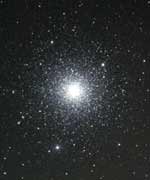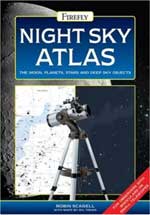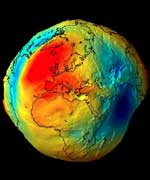
Image credit: NOAO/AURA/NSF
Monday, April 25 – Today marks the 15th anniversary of the deployment of Hubble Space Telescope. While everyone in the astronomical community is well aware of what this magnificent telescope “sees”, did you know that you can see it with just your eyes? The HST is a satellite that can be tracked and observed. Visit Heaven’s Above and enter your location. This page will provide you with a list of visible passes for your area. Although you can’t see details of the scope itself, it’s great fun to track with binoculars or see the Sun glinting off its surface in a scope.
Before the Moon rises tonight, let’s use our binoculars and telescopes to hunt down one of the best globular clusters for the northern hemisphere – M3. You can locate it easily by identifying last week’s study stars, Cor Caroli and Arcturus. Sweep your binoculars in a line between the two and you will discover this ancient beauty about halfway between the pair just east of Beta Comae. The more aperture you use – the more stars you will resolve.
Discovered by Charles Messier on May 3, 1764, this ball of approximately a half million stars is one of the oldest formations in our galaxy. At around 35-40,000 light years away, this awesome globular cluster spans about 220 light years and is believed to be as much as 10 billion years old. To get a grasp on that concept – our own Sun is less than half that age!
Keep a watch on the skies tonight as the Mu Virginid meteor shower reaches its peak at 7 to 10 per hour. Although the rising Moon will hamper observations, you still might catch one of these medium speed meteors radiating from a point near the constellation of Libra.
Tuesday, April 26 – This morning Mercury will reach its greatest western elongation. Southern hemisphere views are highly favoured for this apparition, and you may spot the swift inner planet just before dawn about a handspan above the east/northeast horizon.
On this date in 1920, the Shapely-Curtis debate raged in Washington on the nature and distance of spiral nebula. Shapely claimed they were part of one huge galaxy to which we all belonged, while Curtis maintained they were distant galaxies of their own. Thirteen years later on the same date, Arno Penzias was born. He went on to become a Nobel Prize winner for his part in the discovery of the cosmic microwave background radiation through a simple horn antenna. His discovery helped further our understanding of cosmology in ways that Shapely and Curtis could have never dreamed.
Before the Moon rises tonight, why not take the telescopic challenge to view one of the largest and finest of face-on spiral galaxies? Located about a fist’s width east of last week’s study – Mizar and Alcor – you will find the large, diffuse M101 to be easily within range of the average mid-sized scope. At magnitude 9, you can spot it in larger binoculars, but will require at least a 10″ scope to detect its knotted arms.
For all of Europe and northeastern Africa, the Moon will occult Antares tonight. Be sure to check IOTA for precise times in your area. On this same universal date, it will also occult bright Sigma Scorpii for those in northwestern Australia.
Wednesday, April 27 – Let’s return to the binoculars and small telescopes tonight to find a fantastic galactic cluster known as the M67. Easily located by either going about a fist’s width south of the M44 or a thumb’s width west of Alpha Cancri – this rich, 2500 light year distant open cluster has a stellar population unlike any other. Located about 1500 light years above the plane of the galaxy, the M67 defies the rules by residing in an area not known for galactic clusters – and double defies them by containing population stars similar to a globular cluster. These stars are an indicator of great age, and the M67 may very well be near 10 million years old. For very small binoculars, this beautiful open cluster will appear almost galaxy-like, while progressively larger instruments will resolve it completely.
Thursday, April 28 – Now is your chance to get a first look at the returning Venus. Immediately after sunset, look for it very low on the west/northwest horizon. Try using binoculars to assist you.
Today was a very busy day in astronomy history. Newton published his Principia in 1686 on April 28. In 1774, Francis Baily was born – who went on to revise star catalogs and explain the phenomenon at the beginning and ending of a total solar eclipse which we know as “Baily’s Beads”. 1900 saw the birth of Jan Hendrick Oort, who quantified the Milky Way’s rotation characteristics and envisioned the vast, spherical area of comets outside our solar system that we call the Oort Cloud. Last, but not least was the birth of Bart Jan Bok in 1906 who studied the structure and dynamics of the Milky Way.
Tonight let’s take a look at a visitor from the Oort Cloud, comet 9P/Temple 1. Located just north of Epsilon Virginis, this 10th magnitude comet could be within range of large binoculars, but I would suggest a telescope since there will be many nearby galaxies that could resemble a cometary signature in such a wide field. Even at the eyepiece, this comet will strongly resemble a faint, face-on spiral – but don’t worry – it’s by far brighter than anything nearby. As 9P/Temple 1 is nearing it’s closest approach to the Earth, this will be an outstanding comet to watch in the weeks ahead. Think “Deep Impact”….
For skywatchers, no equipment is necessary to enjoy the Alpha Bootid meteor shower. Pull up a comfortable seat and face orange Arcturus as it climbs the sky in the east. These slow meteors have a fall rate of 6 to 10 per hour and leave very fine trails, making an evening of quiet contemplation most enjoyable.
Friday, April 29 – The Moon is at perigee, its closest approach to Earth – and as luck would have it, reaches maximum libration at 21:00 UT, tipping the north pole our way. If this doesn’t sound very exciting, think of SMART-1 currently up there looking for eternal sunlight! Although the Moon won’t rise until around local midnight, if you’re up late have a go at extreme northern features like Peary, Byrd, Gioja, Main, Challis and Scoresby.
Saturday, April 30 – Frederich Gauss was born on this day in 1777, Known as the “Prince of Mathematics”, Gauss contributed to the field of astronomy in many ways – from computing asteroid orbits to inventing the helioptrope. Out of Gauss’ many endeavors, he is most recognized for his work in magnetism. We understand the term “gauss” as a magnetic unit – a refrigerator magnet carries about 100 gauss while an average sunspot might go up to a 4000. On the most extreme ends of the magnetic scale, the Earth produces about 0.5 gauss at its poles, while a magnetar can produce as much as 10 to the 15th power in gauss units!
While we cannot directly observe a magnetar, those living in the Southern Hemisphere can view a region of the sky where magnetars are known to exist – the Large Magellanic Cloud. Located in the constellation of Dorado, this unaided eye gem is visible even during full moonlight. Stuffed with wonderful features such as the “Tarantula Nebula” – the largest diffuse nebula known in the Universe – and many star clusters, I urge you to get out your telescopes and binoculars and explore…
For southwestern Europe, the Moon will occult 4.5 magnitude star, 59 Saggitarius, on this universal date. Please check the IOTA webpage for details specific to your area.
Sunday, May 1 – On this day in 1949 Gerard Kuiper discovered Nereid, a satellite of Neptune. If you’re up before dawn, you can easily find Neptune less than 2 degrees northwest of bright Mars. While it can be see in binoculars as a bluish “star”, it takes around a 150mm telescope and some magnification to resolve its disc. Today’s imaging technology can even reveal its moons!
Tonight will mark the peak of the Phi Bootid meteor shower whose radiant is near the constellation of Hercules. While the best time to view a meteor shower is around 2:00 a.m. local time, you will have best success watching for these meteors during the late evening before moonrise. The average fall rate is about 6 per hour.
Keep those scopes warm – dark skies are on their way back again! May all your travels be at Light Speed…. ~Tammy Plotner


